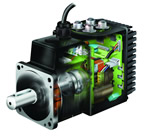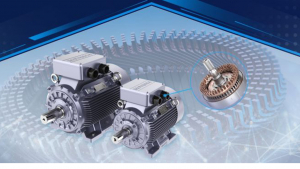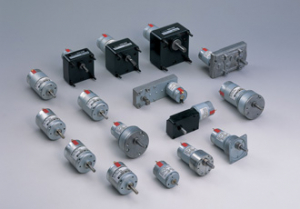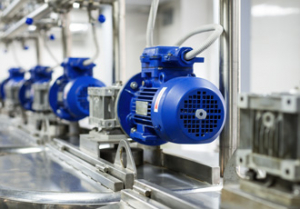Integrated MAC Motor with Power Rating up to 750W
22nd September 2008
Source:
JVL International

JVL’s new additions to the fold comprise two complete, high-capacity MAC Servo Motors with ratings of 400W and 750W. These new products were first revealed at the Danish Herning Tech trade fair this year. The MAC motor consists of a complete servo system, including a high-dynamic AC servo motor, hall-sensor, encoder, power supply, driver and positioning controller, as well as facilities for incorporating various modules such as Profibus, CAN, Nano PLC, etc.
A new type of motor
The MAC motor sets completely new standards for the performance and appearance of servo controls. With a length of only 175mm for a 2.4Nm/750W motor, the MAC motor matches the size of traditional servo motors that have no built-in driver/controller. This has only been possible through the use of an extremely compact motor and the development of electronics and mechanics that utilise the latest technologies and manufacturing methods. At no point has quality been compromised and the motor and electronic components have been specifically selected to withstand the rigorous demands on quality and lifetime required by industrial use.
Advantages
This method of construction is unique, because you only buy what you require for a specific application and thus gain specific functionality at an extremely low price. Space is saved in the control cabinet, noise induced through the use of long motor cables is avoided, and errors due to cabling and components are reduced considerably. With significantly reduced cabling and 30 % of the normal number of components, you can be sure of reducing the number of errors and save on installation costs. In addition, service is much simpler, since the motor and controller can replaced as a single integrated unit.
The basic motor offers the following standard features:
• Operating commands from PC/PLC via RS232/422/485
• Pulse/Direction or quadrature inputs for electronic gearing
• A+B encoder output
• Velocity and torque control, either controlled digitally or via ±12bit, ±10V inputs
• Positioning via digital interface
• Software-controlled end-of-travel stops
• Selection of acceleration, maximum velocity, torque, etc.
• 6th-order servo filter
• Sine commutation with 2000 PPR encoder. (8000 pulses/revolution.)
• Alarm and ”in position” outputs
• 3 inputs and 3 outputs for High Speed start/stop and capture applications
• Internal Power Dump
Via the use of expansion modules, the following additional features are offered:
• Profibus DP module, enabling connection to 12Mbit Profibus.
• CANbus/CANOpen module with 6 in/ 2 out for sensors and PLC
• Nano PLC, containing a single controller that can position on the basis of 8 optically isolated inputs. This module can accomplish 80% of positioning applications.
• High-speed serial RS485 interface that enables multi-axis operation so that robotic movements and advanced XYZ operation is possible at high speed. Can additionally interface directly to IEC61131-3 softPLC.
• Expansion modules are available for IP42 (SUB-D) or IP67 (screw or M12 connector).
• Other modules are under development, e.g. for DeviceNet and Ethernet, and USB modules both as Bluetooth and WLAN modules for wireless data transmission. JVL can also supply customised modules that enable these motors to be adapted to almost any task.
Software
Anyone using the MAC motor will be positively surprised how well the 6th-order filter developed by JVL handles non-linear and undamped systems. The controller operates 100% digitally of course, and easy set-up of the motor is accomplished by the supplied Windows software MacTalk. Internet upgrades are an integrated part of the MAC concept. If an update of MacTalk or the motor’s firmware is required, the user simply selects ”Update MacTalk” or”Update Firmware” and MacTalk will automatically download the latest version from JVL´s Internet server. It cannot be easier.
Power supply
Powering the MAC motors is simple and only requires connection of a mains voltage of either 115 or 230VAC. To ensure correct and effective emergency-stop procedures, the encoder and microprocessor circuitry must be powered using 24VDC.
Switching technology is used to ensure large energy savings and thus reduction of heat generation when the voltage is regulated to the internal control circuits.
The MAC motor sets completely new standards for the performance and appearance of servo controls. With a length of only 175mm for a 2.4Nm/750W motor, the MAC motor matches the size of traditional servo motors that have no built-in driver/controller. This has only been possible through the use of an extremely compact motor and the development of electronics and mechanics that utilise the latest technologies and manufacturing methods. At no point has quality been compromised and the motor and electronic components have been specifically selected to withstand the rigorous demands on quality and lifetime required by industrial use.
Advantages
This method of construction is unique, because you only buy what you require for a specific application and thus gain specific functionality at an extremely low price. Space is saved in the control cabinet, noise induced through the use of long motor cables is avoided, and errors due to cabling and components are reduced considerably. With significantly reduced cabling and 30 % of the normal number of components, you can be sure of reducing the number of errors and save on installation costs. In addition, service is much simpler, since the motor and controller can replaced as a single integrated unit.
The basic motor offers the following standard features:
• Operating commands from PC/PLC via RS232/422/485
• Pulse/Direction or quadrature inputs for electronic gearing
• A+B encoder output
• Velocity and torque control, either controlled digitally or via ±12bit, ±10V inputs
• Positioning via digital interface
• Software-controlled end-of-travel stops
• Selection of acceleration, maximum velocity, torque, etc.
• 6th-order servo filter
• Sine commutation with 2000 PPR encoder. (8000 pulses/revolution.)
• Alarm and ”in position” outputs
• 3 inputs and 3 outputs for High Speed start/stop and capture applications
• Internal Power Dump
Via the use of expansion modules, the following additional features are offered:
• Profibus DP module, enabling connection to 12Mbit Profibus.
• CANbus/CANOpen module with 6 in/ 2 out for sensors and PLC
• Nano PLC, containing a single controller that can position on the basis of 8 optically isolated inputs. This module can accomplish 80% of positioning applications.
• High-speed serial RS485 interface that enables multi-axis operation so that robotic movements and advanced XYZ operation is possible at high speed. Can additionally interface directly to IEC61131-3 softPLC.
• Expansion modules are available for IP42 (SUB-D) or IP67 (screw or M12 connector).
• Other modules are under development, e.g. for DeviceNet and Ethernet, and USB modules both as Bluetooth and WLAN modules for wireless data transmission. JVL can also supply customised modules that enable these motors to be adapted to almost any task.
Software
Anyone using the MAC motor will be positively surprised how well the 6th-order filter developed by JVL handles non-linear and undamped systems. The controller operates 100% digitally of course, and easy set-up of the motor is accomplished by the supplied Windows software MacTalk. Internet upgrades are an integrated part of the MAC concept. If an update of MacTalk or the motor’s firmware is required, the user simply selects ”Update MacTalk” or”Update Firmware” and MacTalk will automatically download the latest version from JVL´s Internet server. It cannot be easier.
Power supply
Powering the MAC motors is simple and only requires connection of a mains voltage of either 115 or 230VAC. To ensure correct and effective emergency-stop procedures, the encoder and microprocessor circuitry must be powered using 24VDC.
Switching technology is used to ensure large energy savings and thus reduction of heat generation when the voltage is regulated to the internal control circuits.
Similar articles
More from JVL International
- Compact slim stepper motor has high motor power and torque 30th April 2018
- New Ethernet protocol for integrated servo motors 28th February 2018
- Next-gen integrated stepper motors are silent running 3rd January 2018
- Integrated Stepper Motors with Industrial Ethernet, Profinet 26th February 2016












Write a comment
No comments